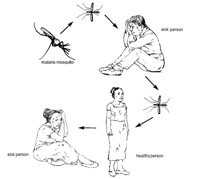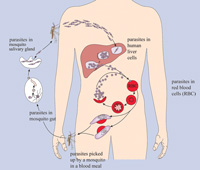5.3.1 Life cycle of the malaria parasite
Human malaria (Plasmodium parasite) is transmitted from an infected person to another person by Anopheles mosquitoes, as shown in Figure 5.4. The parasite spreads by infecting two types of hosts: humans and female Anopheles mosquitoes. The mosquitoes then act as the vector for the parasite. Malaria is a human parasite that is transmitted only between people; malaria is not transmitted from animals to humans or from humans to animals.

Now you are going to learn about the life cycle of the parasite. Please study Figure 5.5 very carefully as it is going to help you understand about the pathology, signs, symptoms and treatment of malaria in the subsequent study sessions.
Malaria in humans develops via two stages: a liver and red blood cell stage. When an infected mosquito pierces a person's skin to take a blood meal, malaria parasites in the mosquito's saliva enter the bloodstream and migrate to the person’s liver. Within 30 minutes of being introduced into the human body, they infect liver cells, multiplying in the liver cells for a period of 6–15 days. In the process they become thousands of parasites which, following rupture of the liver cells, escape into the blood and infect red blood cells, thus beginning the red blood cell stage of its life cycle.
Within the red blood cells, the parasites multiply further, periodically breaking out of their host cells to invade fresh red blood cells. Several replication cycles occur. The pathology and clinical manifestations associated with malaria are almost exclusively due to the red blood cell stage parasites (Figure 5.5). The blood stage parasites are those that cause the symptoms of malaria.

When certain forms of blood stage parasites, called gametocytes, are picked up by a female Anopheles mosquito during a blood meal, they start another, different cycle of growth and multiplication in the mosquito. After 10‒18 days, the parasites are found in the mosquito's salivary glands. When the Anopheles mosquito takes a blood meal from another human, the parasites are injected with the mosquito's saliva and start another human infection when they enter the new person’s liver cells. Thus the mosquito carries the disease from one human to another, acting as a vector. Unlike the infected human, the mosquito vector does not suffer from the presence of the parasites.
The most common way to be infected with malaria is through the natural transmission by mosquitoes, as already described. However, malaria can also be transmitted via blood transfusions or sharing syringes. Mother to child transmission during pregnancy has also been documented, but all the modes of transmission other than via the mosquito are believed to be very rare and unimportant.
5.3 Malaria parasites
